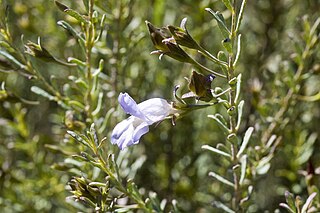Eremophila clavata is a flowering plant in the figwort family, Scrophulariaceae and is endemic to the south-west of Western Australia. It is a low, dense, spreading shrub with narrow grey, club-shaped leaves and pink to purple, sometimes blue flowers.

Eremophila compressa is a flowering plant in the figwort family, Scrophulariaceae and is endemic to a small area in the south west of Western Australia. It is an erect shrub whose leaves have 2 or 3 prominent teeth near their ends, and white or cream-coloured flowers.

Eremophila densifolia is a flowering plant in the figwort family, Scrophulariaceae and is endemic to the south-west of Western Australia. It is usually a low, spreading shrub with densely clustered leaves and lilac to purple flowers.
Eremophila grandiflora is a flowering plant in the figwort family, Scrophulariaceae and is endemic to Western Australia. It is a large shrub with shiny leaves and the largest flowers in its genus and is only known from a restricted area near Paynes Find.

Eremophila purpurascens, commonly known as purple eremophila, is a flowering plant in the figwort family, Scrophulariaceae and is endemic to Western Australia. It is an erect, bushy shrub with warty leaves and spotted, pink to red flowers.

Eremophila pustulata, commonly known as blistered eremophila is a flowering plant in the figwort family, Scrophulariaceae and is endemic to Western Australia. It is an erect shrub with fleshy, warty leaves and purple, lilac, violet or white flowers.
Eremophila buirchellii is a flowering plant in the figwort family, Scrophulariaceae and is endemic to the Mount Augustus National Park in Western Australia. It is an erect shrub with densely clustered leaves, pink, bell-shaped flowers and with most parts of the plant covered with greyish, branched hairs.
Eremophila calcicola is a flowering plant in the figwort family, Scrophulariaceae and is endemic to a small area in the south of Western Australia. It is a low, spreading, short-lived shrub with broad leaves, and pale, greenish-yellow flowers over a long period.
Eremophila ballythunnensis is a flowering plant in the figwort family, Scrophulariaceae and is endemic to Western Australia. It is a small, spreading shrub with narrow oval leaves and mauve-purple flowers with densely hairy sepals.
Eremophila capricornica is a flowering plant in the figwort family, Scrophulariaceae and is endemic to Western Australia. It is a small shrub with woolly branches, grey, hairy leaves and mauve to lilac-coloured flowers with hairy sepals.
Eremophila daddii is a flowering plant in the figwort family, Scrophulariaceae and is endemic to Western Australia. It is a large shrub with sticky branches, hairy leaves and brown and cream-coloured flowers blotched with purple.
Eremophila ferricola is a flowering plant in the figwort family, Scrophulariaceae and is endemic to Western Australia. It is an erect shrub with lance-shaped leaves and yellowish brown to greenish yellow flowers covered with fine hairs. The species is only known from a single location, growing on a banded ironstone hill.
Eremophila hamulata is a flowering plant in the figwort family, Scrophulariaceae and is endemic to Western Australia. It is an erect, woody shrub with sticky branches, narrow, hooked leaves and hairy mauve-purple flowers.
Eremophila jamesiorum is a flowering plant in the figwort family, Scrophulariaceae and is endemic to Western Australia. It is a wispy, sticky shrub with narrow linear leaves and white flowers tinged with pink or mauve. It is only known from a few locations in the Gibson Desert.
Eremophila pusilliflora is a flowering plant in the figwort family, Scrophulariaceae and is endemic to Western Australia. It is a low, open shrub with narrow egg-shaped leaves and flowers which vary in colour from red to cream with a red tinge. It grows in the Pilbara region.
Eremophila laccata is a flowering plant in the figwort family, Scrophulariaceae and is endemic to an area near Carnegie in Western Australia. It is a small, low, spindly shrub with scattered, linear leaves, and pink, flattened bell-shaped flowers.
Eremophila resiliens is a low-growing shrub with deep reddish purple flowers, woolly hairy leaves and that is endemic to Western Australia. It grows on slopes and breakaways near Lake Carnegie.
Eremophila scrobiculata is low, spreading shrub with sessile, linear leaves and lilac-coloured flowers and that is endemic to Western Australia. It grows on the slopes of low, stony hills on Wanna Station.
Eremophila victoriae is small shrub with sessile, egg-shaped leaves and purple flowers and that is endemic to Western Australia. It is only known from two populations in the Great Victoria Desert.
Eremophila yinnetharrensis is a species of flowering plant in the family Scrophulariaceae and is endemic to a restricted area of Western Australia. It is an erect, wispy shrub with sessile, lance-shaped leaves with the narrower end towards the base and purple flowers. It is only known from near Yinnetharra Station in the Gascoyne region.




